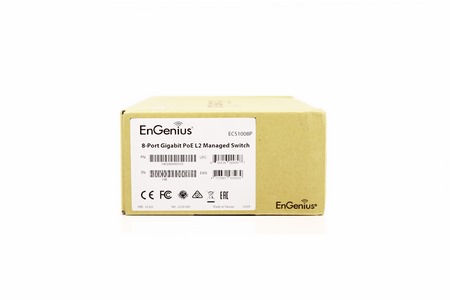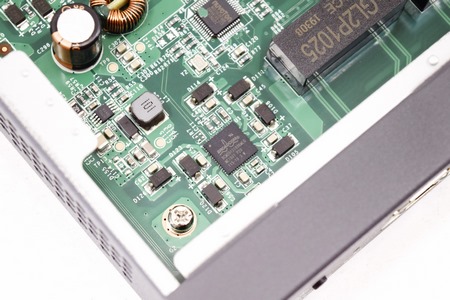INTRODUCTION

For regular consumers network switches may certainly not be quite as popular as modem/routers and even repeaters but they can come equally handy in several scenarios. For example, a good friend of mine finished his new building a few months back and was looking for ways to connect 16 different Ethernet wall sockets with his modem/router and the easiest way was to use a network switch. He had also purchased 2 IP cameras which he obviously wanted to connect with that said switch so he chose to go with a PoE+ model in order to skip the extra power cables (and the additional work required for that). Personally, i use numerous PoE switches both at the office/lab and at home (4 at the time of this review to be exact) which is why I’m always looking to see if there's anything better i can replace them with. That's also why i decided to take a look at the ECS1008P Cloud Enabled 8-Port Gigabit PoE L2 Managed Switch by EnGenius.
EnGenius Technologies is an industry expert in wireless communications and radio frequency (RF) technology. The company has been around for more than 20 years and is focused on delivering feature-rich, long-range, wireless networking solutions for voice and data that empower mobility.
As clearly stated by its product description the ECS1008P features a total of 8 RJ45 Gigabit Ethernet ports which can deliver a total switching capacity of 16Gbps. All 8 RJ45 ports support the PoE standard (electrical power is provided via the Ethernet cable) with a maximum budget of 55W (up to 15.4W per port) making them ideal for use with PoE compatible devices like IP cameras, IP microphones, IP/VoIP telephones and of course access points. However, unlike the majority of Gigabit switches in its class what makes the ECS1008P stand out is its cloud feature which allows the end user to access its primary functions over the EnGenius Cloud service. Of course, EnGenius also packs the ECS1008P with a plethora of features and monitoring tools including 802.3ad link aggregation, 802.3az power save mode, 802.1d spanning tree, 802.1Q tagged VLAN, 802.1p Class of Service (CoS), 802.1X RADIUS authentication, Quality of service (QoS), LLDP, ACL, SNMP v1/2c/3 (simple network management protocol), RMON 1/2/3/9 (remote monitoring), Loopback Detection, MAC/port filtering, IGMP forwarding/snooping, port mirroring and Voice VLAN. So, let's see how the "entry-level" model of the ECS family does, both in terms of performance and of course features.
SPECIFICATIONS AND FEATURES

PACKAGING AND CONTENTS
EnGenius packs the ECS1008P inside a regular cardboard box that just has their logo at the front right next to a cloud enabled sticker.
The serial and part numbers and their barcodes are all printed on a sticker located on the left side.
A quick product description is available at the base of the box right next to the bundle contents.
Nothing new in terms of packaging but sufficient nonetheless.
Along with the ECS1008P switch and its power adapter and cable inside the box EnGenius has also placed two wall mounting screws with rubber covers, 4 rubber feet (desk use) and of course a quick installation guide.
THE ECS1008P EXTERIOR
The 620g heavy EnGenius ECS1008P is a compact 8-port switch that measures just 240mm in length, 105mm in width and 27mm in height.

 To see just how compact, it is i placed it over the TRENDNET TPE-082WS, the QNAP QSW-804-4C and the Linksys LGS124P.
To see just how compact, it is i placed it over the TRENDNET TPE-082WS, the QNAP QSW-804-4C and the Linksys LGS124P.


 At the front we find the activity LEDs, led on/off button, reset button and of course the 8 Gigabit RJ45 PoE ports.
At the front we find the activity LEDs, led on/off button, reset button and of course the 8 Gigabit RJ45 PoE ports.
Both sides of the enclosure are perforated (passive cooling).
Turning the switch around we find an on/off power switch, power port, perforated area and a grounding metal.
As you can see the ECS1008P has 4 areas where you can place the bundled feet and two wall mounting holes on its base.
THE ECS1008P INTERIOR
Accessing the interior is easy and the layout is pretty simple.
At the center of the PCB we see a large heatsink (under which lies the main chip) surrounded by two Realtek serial management interface and shift register LED display controllers, four ACE LAN transformers, 256MB DDR3L SDRAM module by Nanya, 32MB flash memory, Broadcom 8-channel PoE Controller and a single nuvoton 32-bit ARM Cortex-M0 microcontroller.
ENGENIUS CLOUD
There are two ways to control the ECS1008P, one is via the web GUI (192.168.x.x) and one via the EnGenius Cloud which is also what I’ll be using today.
Adding the ECS1008P is simple (you will need to make an account with EnGenius Cloud if you don't already have one) so just head into the inventory tab (lower left corner) and use the serial number of the switch to register it.
After that you will need to go to the switches section in the management tab and add the ECS1008P from the inventory.
Once that's over with you get a quick status page from within the switches section as seen above.
If you haven't used the ECS1008P before the moment you access its functions it will look for available firmware updates (you can't update it manually via the web GUI) after which you can either leave it do it automatically (at a specific day and time which you can adjust) or you can click on the upgrade now button to perform it immediately.
For this review i used firmware version 1.1.36 (the Realtime meters also function properly once the update is finished).
Many of the features can be accessed under the system setting tab (this includes spanning tree, LLDP, Voice Lan, QoS, IGMP snooping and Jumbo Frames.
As expected, you can monitor and control all 8 ports from the Port Setting tab.
Port mirroring and Link aggregation are also supported via their tabs.
There's also a log tab which logs everything in regards to your access to the ECS1008P.
Of course you can see the switch the moment you enter your EnGenius Cloud Dashboard.
TEST BED

TESTING METHODOLOGY
Network switches are very similar to routers so we’ll be using roughly the same testing methodology here as well. So aside the usual networking benchmark by Passmark (updated to v9.0) we'll also be using ATTO (v3.05 for 1GbE tests and v4.00.0f2 for 10GbE tests) and Crystal Disk Mark (v5.1.2 for 1GbE tests and v6.0.2 for 10GbE tests). The reason we are still using ATTO v3.05 and Crystal Disk Mark v5.1.2 for 1GbE tests is due to the fact that we can't re-test all of the switches to ever pass from our lab and also because unlike Passmark results from these versions are inaccurate compared to results from the latest ones. Also, as you’ve already noticed we decided to replace the QCheck software by Ixia with Crystal Disk Mark since we feel it’s a more complete and reliable choice for testing switches. To test all network switches, we are using our top two desktop systems (details above) along with two laptops with which we simulate LAN load. Our systems are placed 15m away (connected with CAT7 cables) from the switch in hand and each test is repeated a total of 6 times after which the average scores are recorded into our charts. Our systems have Windows 10 Pro installed complete with all updates up until the time of this review.
Also just like with Modem/Routers we will also be recording power consumption is these reviews during all our tests and both the lowest and highest numbers will be available in our charts. Finally, when testing network switches with built-in fans (active cooling) we'll also record noise levels using our high precision ExTech HD600 Decibel Meter placed at roughly 5-10cm away.
TEST RESULTS – PERFORMANCE



TEST RESULTS – POWER CONSUMPTION

CONCLUSION

The EnGenius ECS1008P may not be the highest performance switch to ever reach the lab (and it lacks PoE+ support – even though PoE is enough for the majority of uses out there) but it does have two redeeming qualities, easy Cloud access (factory ready) and a very compact size. For the majority of users Cloud access may not be a deal breaker but for professionals and people who want access to a local network at all times it is and that’s something we don’t see a lot in this industry, certainly not with “entry-level” models such as the ECS1008P. Size is equally important especially if you plan on mounting the switch onto a vertical surface like a wall. Again, far from a deal breaker but useful nonetheless. As for available features the ECS1008P is packed with what we see from smart and managed switches, perhaps not to the same degree (or versions) but still more than enough to cover the majority of users out there today.
I was unable to locate the ECS1008P Cloud Enabled 8-Port Gigabit PoE L2 Managed Switch by EnGenius in the states (at least not with a fresh price tag) but it’s currently available in the EU (Amazon.de) for a very fair price tag of 70.95Euros. Overall, the ECS1008P is a very balanced affordable switch, performance is ok, feature set leaves very little to be desired, PoE support should suffice for most uses and the Cloud Access feature is extremely useful. Because all of the above the ECS1008P comes highly recommended by us to anyone looking to get an affordable PoE switch with out of the box Cloud Access.
PROS
- Compact Size
- 8 RJ45 Gigabit PoE Ports
- EnGenius Cloud Access
- Available Settings / Features
- Power Consumption
- Price (For Some)
CONS
- Maximum PoE Power Output Of 55W
- Passive Cooling (Not for Harsh Conditions)

 O-Sense
O-Sense




































.png)

